Basic definition of Princeton offense
The Princeton offense is a basketball strategy that utilizes certain fundamental skills such as passing, cutting, and screening to create one or more scoring opportunities near the basket or around perimeter areas of the court.
Primary rules of the Princeton offense
Maintain good spacing
Players should always strive to maintain good spacing on the court when executing the Princeton offense.
Generally speaking, to maintain the proper amount of spacing, players should be approximately 12 to 15 feet from adjacent teammates.
It should also be noted that at lower levels of competition such as youth basketball, the typical spacing standard of 12 to 15 feet could be potentially reduced down to a smaller distance such as 10 to 12 feet.
Nevertheless, the most important factor overall is that the players keep good spacing.
Additionally, when players are properly spaced out on the court, those simple measures can generally make it more difficult for the opposing team to guard against the various actions within the Princeton offense, especially by way of help defense, particularly from the weak side of the court.
The diagram below shows the primary spots that players could fill on the court while executing the Princeton offense and maintaining good spacing.
Example diagram of primary court spots for Princeton offense
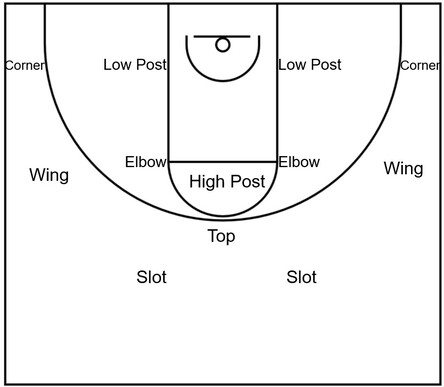
Generally speaking, the main spots that players could occupy within the Princeton offense include the top, the slots, the wings, the high post area including the elbows, the low post areas, and the corners.
Top
The top, sometimes referred to as the top of the key or point, is the general area located behind the three-point line in the middle of the offensive team’s frontcourt.
As it relates to Princeton offense, players will generally occupy the top when it is feasible to do so within offensive execution.
For example, a player might fill the top spot to receive a pass from a teammate or to execute a straight cut directly to the basket.
The top could also be utilized to initiate offensive action but this is generally less common within Princeton offense, particularly when compared with other types of basketball offense strategies.
Slots
The slots, sometimes referred to as the lane line extended areas, are the general areas that are adjacent to the top area as well as the areas between the top and the wings.
Players will typically occupy the slot areas during initial sets to start the Princeton offense and/or to perform various offensive actions such as cutting to the basket after receiving a back screen from a teammate.
Wings
The wings consists of the court areas behind the three-point line that are adjacent to the nearest sideline, which is generally at or above the free throw line extended.
Also, to provide a bit more clarity on the free throw line extended, it is basically an imaginary line that runs from the edges of the free throw line to the sidelines.
Players will usually fill the wing areas during the initial sets to start the offense and/or to execute certain offensive actions such as passing the ball to open teammates.
Corners
The corners comprise the areas behind the three-point line that are in the general vicinity of a sideline and its adjoining baseline.
Within the Princeton offense, players could typically fill the corner areas to space the floor and to clear out one side of the court for a potential isolation play or 2-man action on the strong side.
Players could also occupy the corners to create a possible scoring opportunity via certain actions such as a wide pin down screen on the weak side, which leads to a curl cut to the rim.
High post + Elbows
The high post is the general area that covers the free throw line from one edge to the other as well as the adjacent area that is between the free throw line and the top of the three-point line.
Furthermore, the edges of the free throw line are typically known as the high post elbows or simply, the elbow areas of the court.
Low post
The low post areas are slightly above the basket and just outside of the lane lines, which are borders for the lane.
Moreover, the lane area, also referred to as the key, comprises the area that is between the low posts and below the free throw line.
In reference to the Princeton offense, players would usually occupy the low post area to generate potential scoring opportunities via low post moves or by way of passing the ball to open teammates, which could lead to assists during a game.
What’s more, players could possibly cut from the low post to the high post, which could result in additional scoring options as well.
Perform a backdoor cut when heavily guarded
As a general rule within the Princeton offense, players without possession of the basketball have the freedom to perform a backdoor cut when the opportunity presents itself.
This will typically occur when an off-ball offensive player is overplayed or denied by their defender in an attempt to prevent that same offensive player from receiving the ball.
From there, the offensive player without possession of the ball can try to get open by way of an initial quick step towards the offensive teammate in possession of the ball, followed by an immediate cut to the basket to complete the backdoor cut action.
What’s more, offensive players could potentially use the backdoor cut to take advantage of lackadaisical defense, which could occur when a defender is watching the ball but not their respective defensive assignment.
Essentially, players should read the defense and react accordingly.
The diagram below shows this basic concept. Also, on the adjacent diagram, the offensive players and their defensive counterparts are not currently represented by any sort of meaningful basketball role or position.
Instead, for the time being, the offensive players are simply indicated as 1 and 2 while the defensive players are denoted as X1 and X2, primarily for demonstrative purposes.
Example diagram of simple backdoor cut
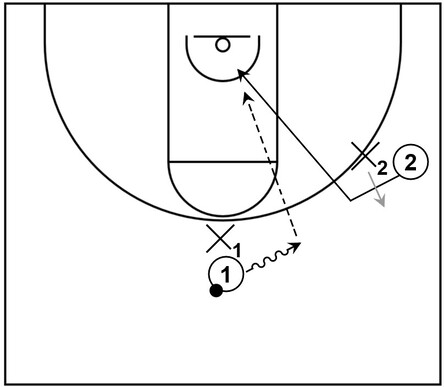
This diagram features an example of a backdoor cut from an offensive player near the right side wing because of denial defense by an off-ball defender.
To give a brief description of the initial setup, 1 begins at the top in possession of the basketball, represented by the black dot while 2 fills the right side wing.
Essentially, 2 would like to receive the ball from 1. However, 2 is currently being overplayed and denied the ball by X2, represented by the gray arrow.
Therefore, 1 takes a dribble towards 2, which is represented by the arrow with a wavy line. That dribble action is also an automatic signal that 2 should execute the backdoor cut.
From there, 2 complies with the dribble action and backdoor cuts to the basket.
Following that, 2 receives the ball from 1 represented by the dotted arrow, and scores at the rim via a layup or slam dunk.
It should be mentioned as well that during the backdoor cut action, the offensive player in possession of the ball should generally throw a bounce pass to the cutting player whenever possible.
The main reason is that it is usually more challenging for the overplaying defender or other potential defenders to deflect or steal the low bounce pass as opposed to a higher air pass.
However, in some instances, an air pass could be more feasible such as when an offensive player cuts to the basket from the corner while the adjacent defender is not paying attention.
In that case, it could make more sense for the player in possession of the ball to throw a lob pass over the top of the defenders to the off-ball player performing the backdoor cut.
General benefits of Princeton offense
The Princeton offense is generally beneficial because it is a team-oriented offense, it could potentially produce multiple scoring options, and it could be executed as a continuity pattern to create even more possible scoring opportunities.
Team-oriented offense
Essentially, the Princeton offense generally emphasizes all five players on the court and it does not necessarily require that one or two players carry most of the scoring load.
This is mainly due to the various team-based scoring options within the Princeton offense, which generally revolve around players executing the fundamental offensive skills of passing, cutting, screening, shooting, as well as dribbling to one degree or another.
These particular actions are foundational to basketball offense in general and players do not need to be extremely talented to perform them, especially in relation to the Princeton offense.
It should be mentioned though that if one or more players are highly skilled and/or very talented, then that could lead to even more potential scoring opportunities.
Furthermore, the Princeton offense could be utilized by traditional teams as well as undersized teams that may not possess any traditional post players or only one or two post players.
Nevertheless, the Princeton offense is generally most efficient for positionless teams in which all five players can interchange roles or at the very least, four players can switch roles while one player remains in the same role, particularly operating from the post areas of the court.
Multiple ways to score points
Via low post actions
Within the Princeton offense, teams can execute one or more passes to produce scoring opportunities from the low post area, typically via a special set of actions known as the Low Post series.
The diagram below demonstrates a very basic scoring option via the low post area.
Example diagram of a basic low post scoring option
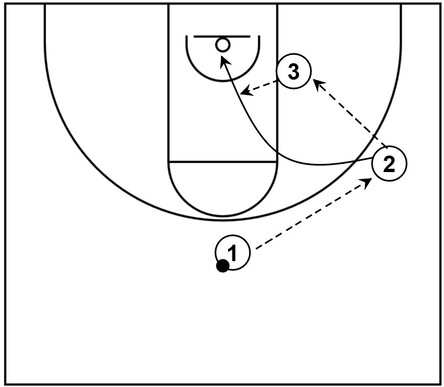
In terms of the initial setup, 1 begins near the top, 2 fills the right side wing area, and 3 takes up space near the right side low post.
From there, 2 receives the ball from 1 and afterwards, 3 receives the ball from 2.
Once 3 has possession of the ball in the low post area, 2 cuts to the basket while remaining below 3. This is generally known as pass and cut action from 2.
What’s more, the actual cut itself utilized by 2 is typically referred to as a Laker cut.
Following that, 2 receives the ball again from 3 and then scores at the rim via a layup or dunk.
It should be mentioned as well that when 2 passes the ball to 3 and then receives it again in the same sequence, that is generally referred to as give and go action.
Via high post actions
Teams could make use of the high post area, which is actually a large emphasis of the Princeton offense.
Additionally, undersized teams, as referenced earlier, can utilize the high post area to potentially offset the size of larger low post defenders by drawing them away from the basket.
That, in turn, could possibly result in one or more scoring opportunities near the basket or near perimeter areas of the court.
The Princeton offense also comprises a special set of actions known as the Point series that emphasizes passing the ball into the high post area and then creating scoring possibilities near the basket or near perimeter areas of the court.
The example diagram below displays a very basic scoring opportunity created by way of high post action.
Example diagram of a basic scoring opportunity from high post action
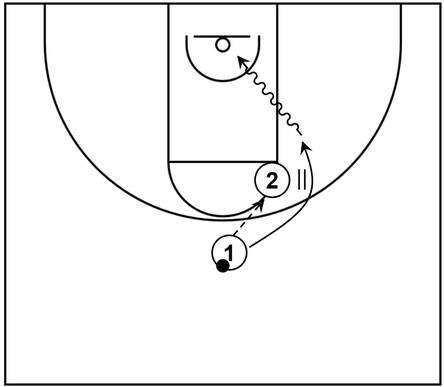
For the initial setup, 1 starts at the top while 2 fills the right side high post elbow area. Next, 2 receives the ball from 1 who also immediately follows that pass.
From there, 1 receives the ball from 2 via a handoff, represented by the double pipe symbol. After that, 1 could dribble into the lane and score at the rim.
Via screening actions
Offensive players can set and use certain types of basketball screens, ultimately to score points near the basket or near perimeter areas of the court.
In addition, the Princeton offense features a special set of actions known as the Chin series that utilizes certain screens to create one or more scoring opportunities.
The example diagram below shows a very basic scoring opportunity produced via fundamental screening action.
Example diagram of a basic scoring opportunity from screening action
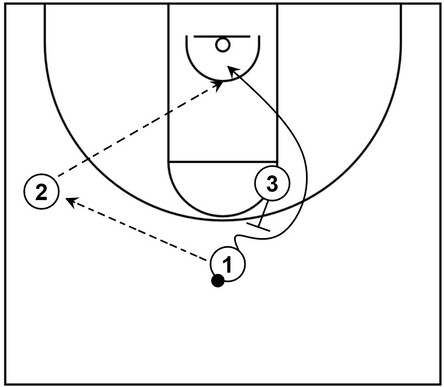
In reference to the initial setup, 1 begins at the top, 2 starts near the left side wing, and 3 fills the high post elbow area.
Next, 2 receives the ball from 1 and immediately afterwards, 1 cuts to the basket via a back screen set by 3. From there, 1 receives the ball from 2 and scores at the rim.
Via backdoor cuts
As mentioned in the primary rules section, offensive players can use the backdoor cut when there is an opportunity to do so, mainly based on how a defender is guarding against those players.
The example diagram below demonstrates a simple scoring play that features a backdoor cut, particularly from the slot area.
Example diagram of a basic backdoor cut from slot area
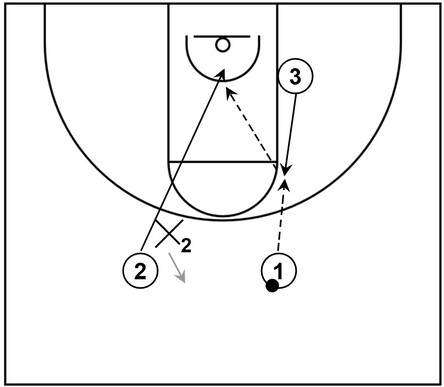
For the setup, 1 fills the right slot with possession of the ball, 2 takes up the left slot, and 3 initially fills the right side low post area.
Next, 2 would like to receive the ball from 1. However, X2 uses denial defense with a hand in the passing lane, indicated by the gray arrow, to hinder that potential slot to slot pass.
To counter that denial action, 3 lifts up to the strong side high post area and receives the ball from 1 as an alternative recipient.
Furthermore, once 3 gains control of the ball, 2 immediately executes a backdoor cut to the rim, receives the ball from 3, and scores via a layup or dunk.
In addition, it should be noted that the cut to the high post and subsequent backdoor cut from the opposite slot area is very similar to standard blind pig action, which is also used as an automatic sequence within the Triangle offense.
Via continuity patterns
It is possible for certain actions of the Princeton offense to be carried out as a continuity pattern.
Essentially, when a scoring opportunity is not available on one side of the floor, the offensive team could reverse the ball by passing it to the other side and then executing the actions once more.
Theoretically, this could happen continuously as long as there is enough time on the game clock or shot clock and as long as the offensive team does not commit a turnover to the opposing team.
The example diagrams below showcase a very basic continuity pattern that could be used to produce scoring opportunities near the basket or perimeter.
Example diagram of a basic continuity pattern: Part 1
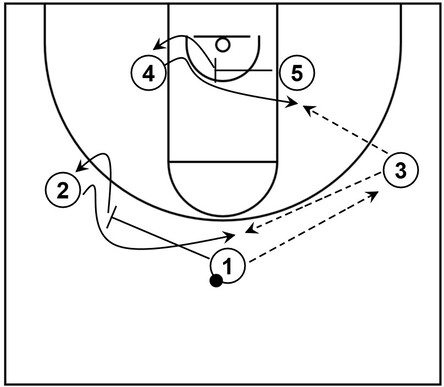
The initial setup comprises three players near perimeter spots and two players near the low post areas.
More specifically, 1 starts at the top, 2 takes up the left side wing, 3 fills the right side wing, 4 settles in the left side low post, and 5 occupies the right side low post.
From there, 3 receives the ball from 1 and that leads to two separate but simultaneous off-ball actions.
Basically, 4 cuts to right side low post by way of a cross screen set by 5 and at the same time, 2 cuts to the top via the pass and screen away action executed by 1.
Afterwards, 4 could receive the ball from 3 and score via a low post move. Conversely, 2 could receive the ball from 3 and take the open jump shot.
It should be mentioned as well that after setting the screens, 5 fills the vacant left side low post area and 1 fills the empty left side wing.
Example diagram of a basic continuity pattern: Part 2
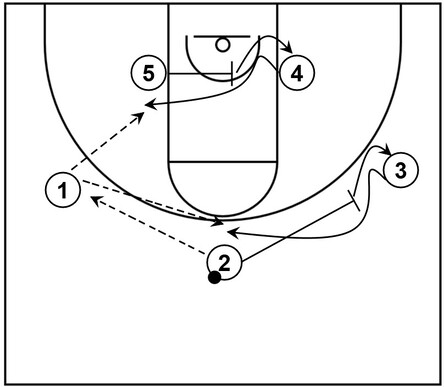
If 2 is not open for the shot, then 1 could receive the ball near the left side wing and that essentially starts the continuity pattern.
In essence, 4 cuts to the left side low post area via a cross screen set by 5 and at the same time, 3 cuts to the top via screen away action executed by 2.
The screening players also fill the respective vacant spots.
Following that, 5 could receive the ball and score via a low post move or 3 could receive it and take the open jump shot.
If 3 receives the ball but is not open for the shot, then 3 could reverse the ball to the right side wing and execute the continuity pattern once more.
As stated earlier, this simple pattern of continuity offense could keep going as long as the clock does not expire or as long as the offensive team does not commit a turnover.
Possible drawbacks to consider for the Princeton offense
Discipline and patience are generally required from players
When running the Princeton offense, players generally need to be disciplined and patient to generate the best scoring opportunity for the team as a whole.
This means that the players may have to perform fundamental skilled actions such as passing, cutting, or screening multiple times before taking a field goal, which should typically be the highest percentage shot available at the time.
However, if players are not disciplined and patient, then that could possibly lead to lower quality bad shots.
This, in turn, could also result in offensive output that is very poor overall, a decrease in team chemistry, and worse of all, game losses.
Additionally, if the concepts and various actions of the Princeton offense are consistently practiced over a period of time, then that could help players improve their discipline and patience as well.
Sufficient basketball IQ is recommended
Generally speaking, it is recommended that players have at least an adequate basketball IQ when running the Princeton offense.
In essence, players should have a basic understanding of fundamental offensive concepts because multiple scoring opportunities could present themselves based on what the defense does.
However, if players do not possess a sufficient basketball IQ, then it could be somewhat of a challenge for them to quickly recognize various scoring possibilities that could be available for only a brief period of time.
Furthermore, it is very probable that players with a below average basketball IQ won’t be able to read and react to the defense in an efficient manner.
Therefore, the Princeton offense is most likely not very feasible for absolute beginners or basketball teams with inadequate chemistry between players.
General information about initial sets within the Princeton offense
This section contains general information about the different initial sets that could be used to start various actions within the Princeton offense.
Additionally, as mentioned previously in terms of types of teams and basketball roles, the Princeton offense could be implemented by traditional teams, undersized teams, or positionless teams.
However, in reference to the diagrams within this section as well as subsequent sections, each offensive player is indicated by a number that generally represents one of the standard basketball positions and each defensive player has a correlated number to a similar position that is shown alongside the letter X.
Essentially, 1 and X1 are the offensive and defensive point guards, respectively.
2 and X2 are the offensive and defensive shooting guards, respectively.
3 and X3 are the offensive and defensive small forwards, respectively.
4 and X4 are the offensive and defensive power forwards respectively.
Lastly, 5 and X5 are the offensive and defensive centers, respectively.
Putting it another way, 1 and 2 are the guards. 3 and 4 are the forwards. 5 is a traditional post player.
For demonstrative purposes, the players will usually remain in these particular basketball roles unless stated otherwise.
Initial set common formations
2-guard front: Variation 1
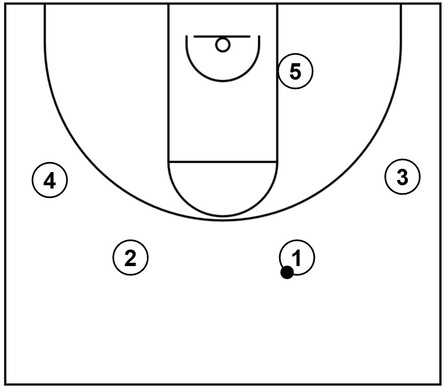
This is an example of an initial set for the Princeton offense that consists of a 2-guard front, particularly in the slot areas.
Furthermore, two forwards are located on the wings and a traditional post player is positioned near the low post area on the right side of the court.
On the basketball diagram, 1 and 2 are located in the right and left slot areas respectively while 3 and 4 are near the right and left wing areas respectively.
Additionally, 5 fills the right side low post block on the same side as 1 and 3.
It should be noted that this particular set can also be referred to as a 2-2-1 alignment or formation.
To give more clarity, the digits that are to the left or right of a dash (-) represents the number of offensive players located within a general region of the court.
What’s more, if a formation or alignment contains only one dash, then the number of players to the left of the dash would represent the front or top region while the number of players to the right of the dash would represent the back or bottom region.
Similarly, if a formation or alignment contains two dashes, then the number of players to the leftmost of the dashes would represent the front or top region, the number of players in between the leftmost and rightmost dashes would represent the middle region, and the number of players to the rightmost of the dashes would represent the back or bottom region.
So, with all that said, for the case of the 2-2-1 formation, this basically means that there are two offensive players located at the front region (i.e. the slot areas), two offensive players located in the middle region (i.e. the wing areas), and one offensive player located in the back region (i.e. the low post area).
This also explains why this particular set is generally referred to as a 2-guard front. That is to say, there are specifically two guards located in the front region of the alignment/formation.
It should be noted too that this terminology would typically apply to other offensive formations in addition to defensive sequences.
For example, the 2-1-2 press defense signifies that there are two defenders at the front of the press, one defender in the middle region, and two defenders in the back region.
2-guard front: Variation 2
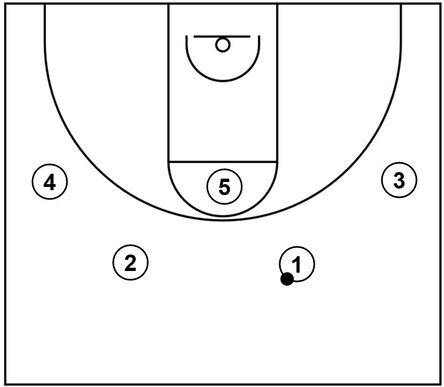
This is another variation of the 2-guard front. However, this time, the traditional post player fills the high post area as opposed to the low post area while the guards and forwards fill the slots and wings respectively.
Furthermore, this particular set is also generally known as a 2-3 formation. This is because there are two players in the front region of the formation, which are the two guards, hence the 2-guard front.
Additionally, there are three players in the back region, which comprises the two forwards and the traditional post player.
4 out 1 in
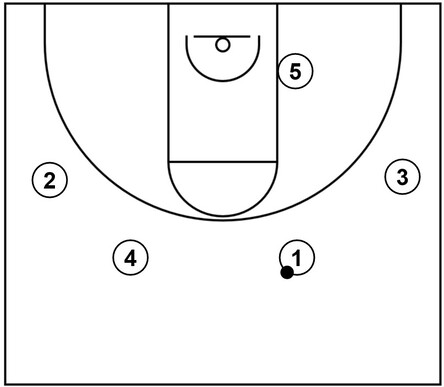
This is an example basketball diagram of an initial set for the Princeton offense that features four players outside of the three-point line and one player inside near the low post area.
Generally speaking, this is typically referred to as a 4 out 1 in set and it is also the primary formation utilized within the 4 out 1 in motion offense.
In terms of the players on the court, 1 begins at the right slot area while 4 takes up space in the left slot.
Moreover, 2 and 3 fill the left and right side wing areas respectively while 5 occupies the right side low post area.
Primary actions after initial set formation
The primary actions of the Princeton offense usually begin with a slot to wing pass, slot to slot pass, or a slot to high post pass.
This typically occurs after the team establishes the initial set such as the 2-guard front, which could be the 2-2-1 or 2-3 alignment.
Putting it another way, once the team forms the proper alignment, the play initiator in possession of the ball, usually the point guard, will generally throw a pass to the adjacent wing, opposite slot, or high post area to start the Princeton offense.
The example diagrams below attempt to demonstrate these concepts.
Slot to wing pass
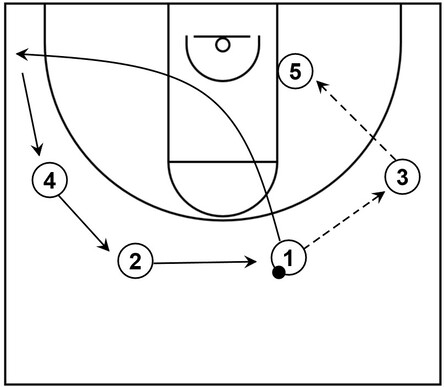
This is a simple example of a slot to wing pass after the team establishes a 2-2-1 alignment.
In terms of setup, 1 and 2 occupy the right and left slots respectively. 3 and 4 are near the right and left wings respectively. 5 fills the right side low post area.
Next, 3 receives the ball from 1 who immediately cuts through to the opposite corner. Following that, 2 cuts across the top area to fill the vacant right slot area.
At the same time, 4 fills the empty left slot while 1 takes up the left side wing that was vacated by 4.
Afterwards, 5 could receive the ball from 3 and additional actions could occur from there.
What’s more, as a side note, this example is very similar to initial action within the Low Post series of Princeton offense.
More basic details about that particular series will be given in another section later on.
Slot to slot pass
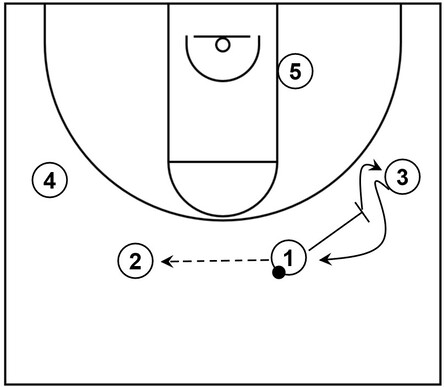
This is an example of a basic slot to slot pass after the team establishes a 2-2-1 alignment.
The setup is similar to the previous diagram. So 1 and 2 occupy the right and left slots respectively. 3 and 4 are near the right and left wings respectively. 5 fills the right side low post area.
Next, 2 receives the ball from 1 and then 3 cuts to the right slot area via the screen that is set away from the ball by 1.
Additionally, after setting the screen, 1 fills the vacant right side wing area.
Slot to high post pass
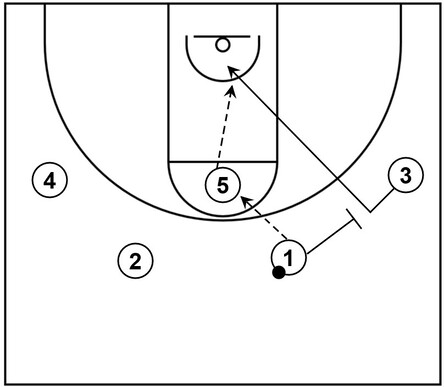
This is a simple example of a slot to high post pass after the team constructs a 2-3 alignment.
As it relates to the setup, 1 and 2 occupy the right and left slots respectively. 3 and 4 are near the right and left wings respectively. 5 fills the high post area.
Next, 5 receives the ball from 1 who immediately screens away for 3. However, 3 rejects that screen and performs a backdoor cut to the rim.
Following that, 3 receives the ball from 5 and scores by way of a layup or dunk.
Secondary actions after initial set formation
This section contains basic examples of secondary actions after the initial set formation that could be essentially used as offensive counters if the defense attempts to hinder or prevent the primary actions.
Example 1 – Part 1: Dribble at wing
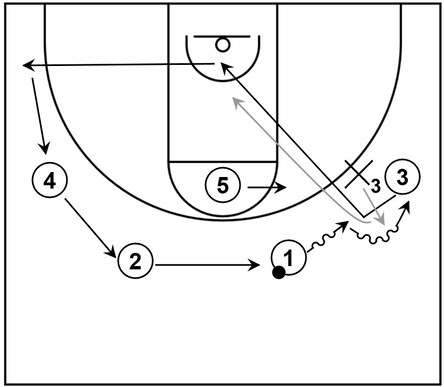
This is an example of secondary action that could happen when a slot to wing pass is not feasible.
In terms of the setup, the offensive team utilizes a 2-3 alignment.
To start, 1, who is in the right slot, would like to pass the ball with 3 as the designated recipient near the right side wing.
However, X3 plays denial defense to hinder or prevent the easy slot to wing pass, shown via the gray arrow.
Therefore, 1 executes the secondary action by dribbling towards the right side wing.
This leads to an automatic backdoor cut by 3 towards the basket.
Nevertheless, X3 is able to cut off the potential passing lane by mirroring the path of 3, also indicated by a gray arrow.
So, 3 is not able to receive the ball from 1 and as a result, 3 continues to cut through to the left side corner on the weak side.
Moreover, 1 continues to dribble to the empty right side wing. Additionally, 2 fills the right slot previously occupied by 1.
What’s more, 4 fills the vacant left slot, 3 replaces at the left side wing area, and 5 slides towards the right side elbow area.
Example 1 – Part 2: Back screen
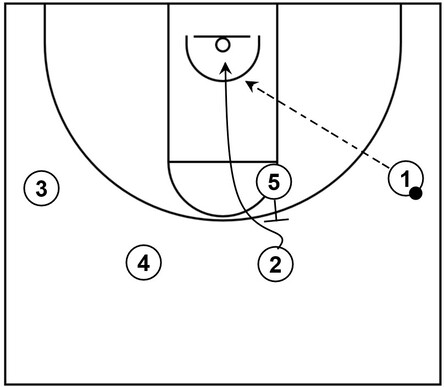
With 1 still in possession of the ball near the right side wing, 2 could cut to the basket via a back screen set by 5.
Afterwards, 2 could receive the ball from 1 and possibly score via a layup or dunk.
Example 2 – Part 1: Dribble at slot
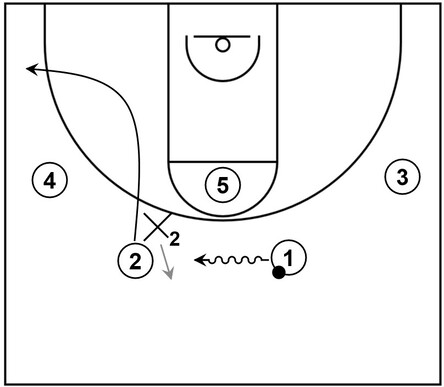
This is an example of secondary action that could happen when a slot to slot pass is not available.
For the setup, the offensive team uses a 2-3 alignment, similar to the previous diagram.
To begin, 1, who is in the right slot, would like to pass the ball with 2 as the selected recipient in the opposite left slot.
However, X2 implements denial defense to hinder or prevent the easy slot to slot pass, represented by the gray arrow.
Therefore, 1 dribbles at the left slot and 2 cuts through to the left side corner.
Example 2 – Part 2: Pick and roll
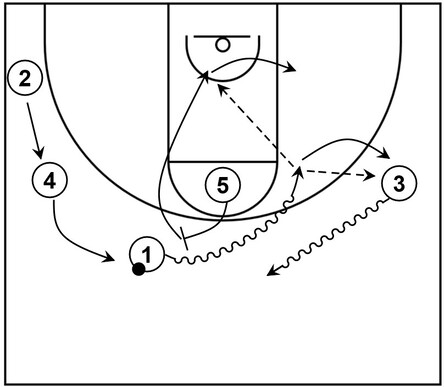
This next part of the example features a basic pick and roll, which can then flow back into an initial setup.
To start, 1 uses an on-ball screen set by 5 who also rolls to the basket.
Afterwards, 1 could take the mid-range jump shot if open or pass inside to 5 as the recipient, who could then attempt to score points via a layup, dunk, or low post move.
On the other hand, if those scoring options are not feasible, then 3 could receive the ball from 1 via a short pass to the right side wing.
Following that, 3 can begin dribbling towards the right slot while 1 fills the vacant right side wing.
At the same time, 4 could fill the left slot, 2 could fill the left side wing, and 5 could step out of the lane to occupy the right low post area.
From there, the offense has effectively flowed back into an initial formation of a 2-2-1.
Example 2 – Part 3: 2-2-1 formation
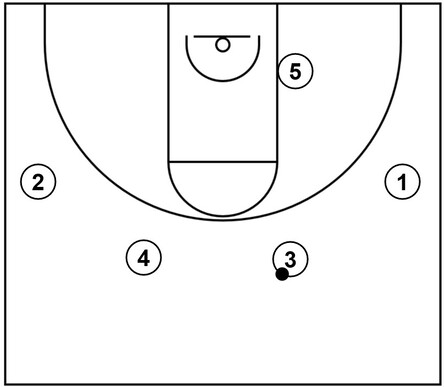
This is simply a demonstration of how the offensive players have flowed back into the 2-2-1 formation. From this point, the players can execute similar or different offensive actions.
Also, notice that with the exception of 5, the other four players are located in different areas of the court when compared to the original alignment.
Again, in the Princeton offense, players are usually interchangeable. For this instance, four players are switching roles while one player, the traditional post, remains in the same role.
Examples of basic actions within the Princeton offense
Basic actions within the Princeton offense will typically begin with the slot to wing pass, slot to slot pass, or slot to high post pass.
In essence, the basic actions could be thought of as an extension of the primary actions after the initial set formation.
The following diagrams feature simple examples of the basic actions, which also comprise a pass and screen away set, a pass and cut set, as well as a pass and follow set.
Pass and screen away
This example diagram demonstrates a pass and screen away set initiated from a 2-3 alignment with scoring options derived from a high post pass.
Scoring options from high post pass
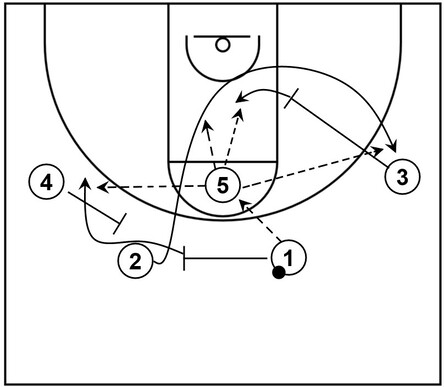
To begin, 5 receives the ball from 1 and after that, 1 screens away towards the opposite slot where 2 is currently located.
However, 2 rejects the screen and begins cutting to the basket. From there, 2 could receive the ball from 5 and score at the rim.
Otherwise, 2 could continue through to the right side wing via a pin down screen set by 3.
As that happens, 3 could slip to the basket and 1 could cut towards the left side wing via a flare screen set by 4.
Following that, 5 could pass to either 2 or 1 for jump shot opportunities or 5 could pass inside with 3 as the recipient immediately after the slip action.
Pass and cut
This is an example of a pass and cut set initiated from a 2-2-1 alignment with multiple scoring opportunities.
Part 1: Slot to slot pass
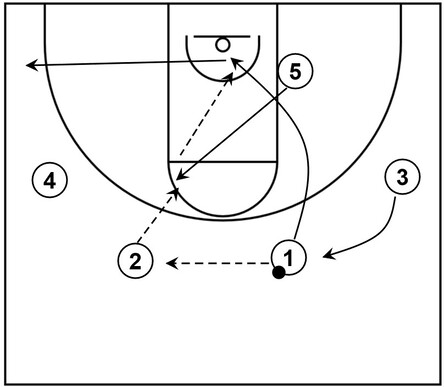
To start, 1 executes a slot to slot pass with 2 as the receiver.
Additionally, that passing action is a signal for 5 to flash cut to the left side elbow, which is also the current strong side of the court.
Next, 1 cuts to the basket and can receive the ball from 5 for a possible layup at the rim.
If 1 is not open, then 1 can continue through to the left side corner and 3 can fill the vacant right slot area.
Part 2: Handoff
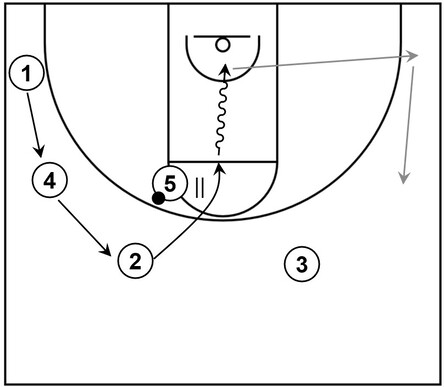
If 1 does not receive the ball, then 2 can cut towards the basket and receive a handoff from 5. Afterwards, 2 can continue to dribble towards the rim and score via a layup or dunk.
However, if 2 does not receive the handoff, then could continue through to the right side corner and eventually the right side wing area, indicated by the gray arrows.
Simultaneously, 4 can fill the empty left slot area and 1 can replace at the left side wing.
Part 3: Flare screen
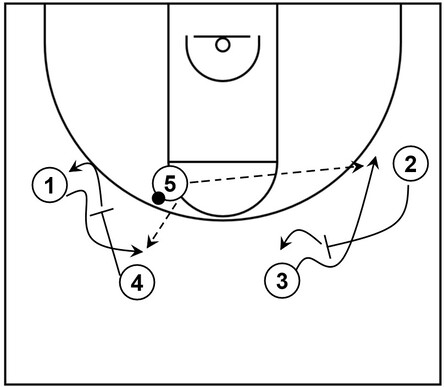
Next, 3 can cut back towards the right side wing area via a flare screen set by 2. At the same time, 1 could cut towards the left slot via an away screen set by 4.
From there, 5 can throw the ball to either 2 or 1 as recipients for possible jump shot opportunities behind the three-point line.
Also, if 1 receives the ball and a shot is not available, then 1 could initiate a new set as the four perimeter players have re-established the 2-3 alignment.
Pass and follow
This is an example of a pass and follow set initiated from a 2-2-1 alignment with various scoring opportunities near the basket as well as pick and roll action.
Part 1: Slot to slot pass
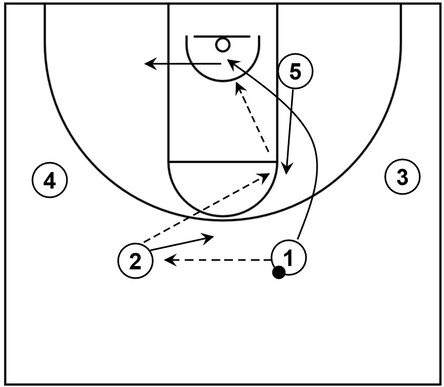
To start the basic action, 2 receives the ball from 1 via a slot to slot pass.
Following that, 5 lifts up towards the right side high post elbow area and receives the ball from 2.
Once that occurs, 1 cuts to the basket, receives the ball from 5, and scores at the rim via a layup.
However, if 1 is not open to gain possession of the ball from 5, then 1 cuts to the left side low post area while 2 moves a short distance to the top from the left slot.
Part 2: Screen rejection and down screen
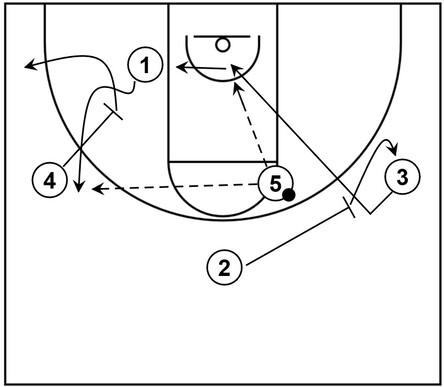
Next, 2 can now follow towards the initial high post pass to set a screen near the right side wing.
However, 3 can reject that screen, backdoor cut to the rim, receive the ball from 5, and score via a layup or dunk.
Also, as that action happens, 1 cuts to the left side wing via a down screen set by 4.
From there, if 3 is not open on the backdoor cut, then 5 could pass the ball with 1 as the recipient for a potential jump shot.
Alternatively, if 1 or 3 do not gain possession of the ball, then 3 could move to the left side low post area.
Furthermore, 4 could cut to the left side corner and 2 could fill the vacant right side wing following the screening actions.
Part 3: Pick and roll
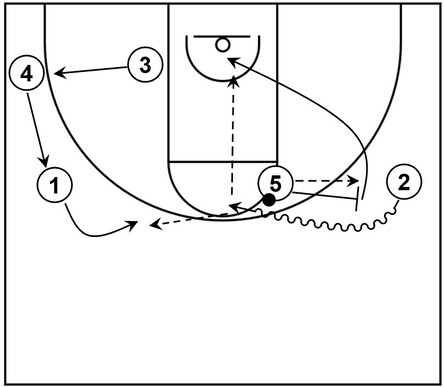
To continue the basic action, 5 could pass to the right side wing with 2 as a recipient and follow that pass with an on-ball screen.
2 could dribble towards the high post area via the on-ball screen while 5 rolls to the basket.
Moreover, as that happens, 1 slides over to the extended left slot, 4 fills the vacant left side wing, and 3 fills the empty left side corner.
From there, 2 could pass inside to 5 as the receiver for a score around the rim or 2 could take the jump shot if that is open.
Alternatively, 2 could pass to the extended left slot, currently occupied by 1 for another potential jump shot opportunity.
Example of primary actions within the Low Post series
The Low post series comprises a special set of actions within the Princeton offense that emphasizes creating close-range or perimeter scoring opportunities, primarily by playing through the team’s best low post player.
Moreover, for this example, the players initiate the offense from a 4 out 1 in formation.
Part 1: Slot to wing pass
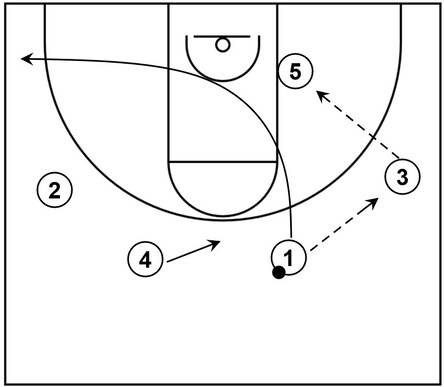
At the start, 1 executes a slot to wing pass with 3 as the recipient.
Afterwards, 1 cuts through to the left side corner while 5 receives the ball from 3. Furthermore, 4 moves from the left slot to the top area for the time being.
Part 2: Straight cut
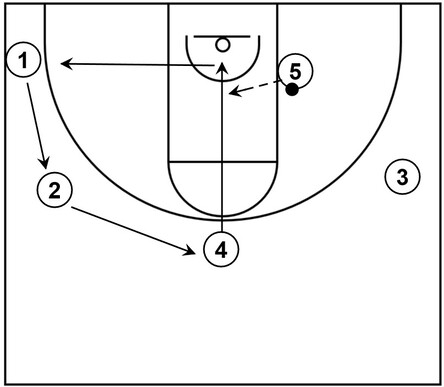
Next, 4 executes a straight cut directly to the basket and could receive the ball from 5 to create a possible scoring opportunity at the rim.
However, if 4 is not open to receive the ball, then 4 continues to cut through to the left side corner. In addition, as 4 is cutting to the corner, 2 fills the empty space at the top while 1 fills the vacant left wing area.
Part 3: Split cut
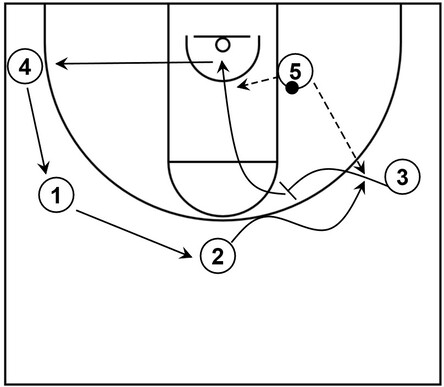
If 4 is not open, then 3 can execute a split cut and screen away from the ball.
2 can use that screen to fill and replace the right side wing that was previously occupied by 3.
Additionally, 3 could slip the screen and cut to the basket, especially as a counter to potential switch defense.
From there, 2 could receive the ball for a possible open jump shot or 3 could receive it instead for a scoring opportunity at the rim.
However, if 2 or 3 are not open, then 3 could continue to cut towards the left side corner.
As that occurs, 1 could fill the top area while 4 fills the left side wing area.
Following that, the perimeter players could execute the straight cut or split cut actions continuously until the best scoring opportunity presents itself.
Alternatively, 5 could always attempt to score points by way of a low post move such as a hook shot as well.
Example of primary actions within the Chin series
The Chin series comprises a special set of actions within the Princeton offense that primarily consists of utilizing the back screen and flare screen to create scoring opportunities near the basket or near perimeter areas of the court.
Additionally, for this example, the initial setup is from a 4 out 1 in formation.
Part 1: Dribble handoff
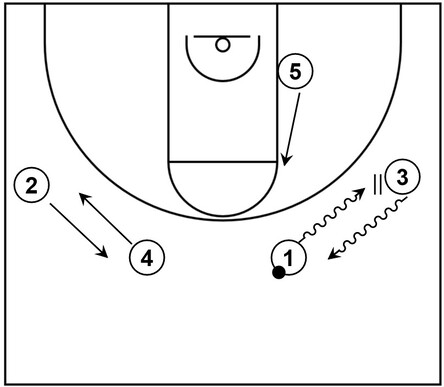
To begin, 1 executes a dribble handoff with 3 near the right side wing while 2 and 4 interchange spots on the opposite side of the floor.
Furthermore, while that action takes place, 5 lifts up to the right side high post elbow area.
Part 2: Back screen

Next, 3 executes a slot to slot pass with 2 as the receiver and then 2 makes a slot to wing pass with 4 as the recipient.
Following that, 3 cuts to the rim via the back screen set by 5, receives the ball from 4, and then scores via a layup.
However, if 3 is not open, then 3 simply continues to cut through to the left side corner and 5 moves to the center of the high post area.
Part 3: Flare screen
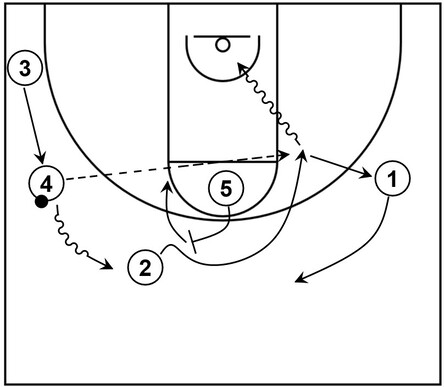
Next, 2 cuts toward the right side elbow area via the flare screen set by 5.
Afterwards, 2 could receive the ball from 4 and take the mid-range jump shot or attack the rim to score points via a layup or possible slam dunk.
Nevertheless, if 2 is not open, then 1 could cut to the empty right slot and 2 could fill the vacated right side wing area.
Additionally, 4 could dribble up to the left slot area while 3 fills the open left side wing spot. What’s more, 5 can move to the left side elbow area following the screening action.
At this point, it is now feasible to execute a continuity pattern, which is demonstrated in the next part.
Part 4: Back screen from continuity
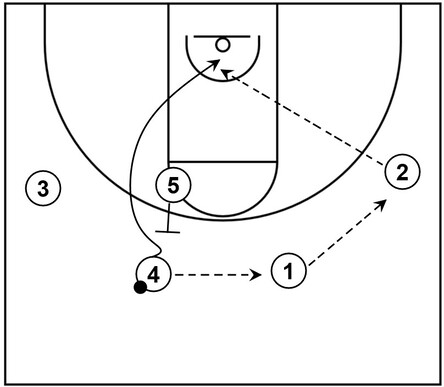
To start the continuity pattern, 4 executes a slot to slot pass with 1 as the receiver.
After that, 1 performs a slot to wing pass with 2 as the recipient.
Next, 4 cuts to the basket via the back screen set by 5, receives the ball from 2, and scores via a layup or dunk.
It is also possible to execute the flare screen action again as well and this pattern could continue until the team produces a high percentage shot near the basket or near the perimeter.
Examples of primary actions within the Point series
The Point series comprises different sets or sub-series known as Point away, Point under, and Point over that can produce various scoring opportunities.
In essence, a player in possession of the basketball near the top will generally pass it into the high post and then cut away, cut under, or cut over the high post player to create one or more possibilities to score points near the basket or near perimeter areas of the court.
The following subsections and diagrams demonstrate these concepts.
Point Away
This is a basic example of primary actions within the Point away set initiated from a 2-2-1 formation.
Part 1: Slot to slot pass and cut through
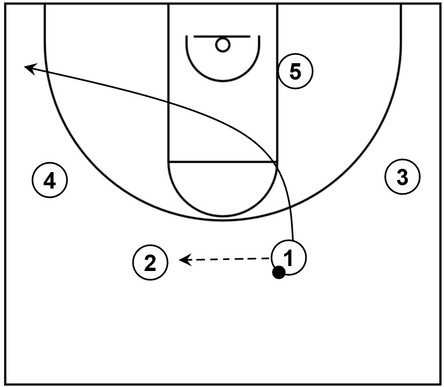
To begin the point away action in this case, 1 throws a slot to slot pass with 2 as the receiver. Afterwards, 1 cuts through to the left side corner.
Part 2: High post entry pass
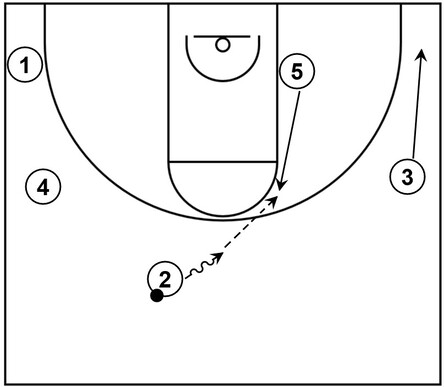
Next, 2 dribbles from the left slot towards the top and as that happens, 5 lifts to the right side elbow area while 3 spaces out to the empty right corner.
Following that, 5 simply receives possession of the ball from 2.
Part 3: Screen away and rejection
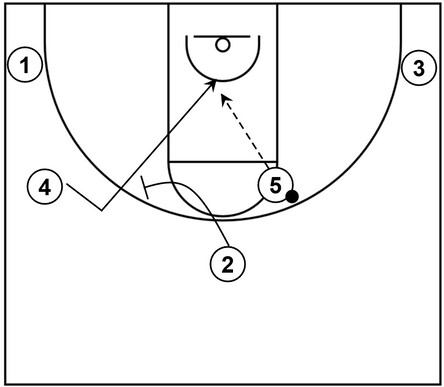
Next, 2 cuts away from the ball to set a screen in the vicinity of the left elbow area.
Afterwards, 4 moves toward the screen as if to use it initially. However, 4 quickly rejects the screen and backdoor cuts to the basket.
Following that, 4 receives the ball from 5 and scores via a layup at the rim.
Point Under
This is a basic example of primary actions within the Point under set, also initiated from a 2-2-1 formation.
Part 1: Cut through and flash
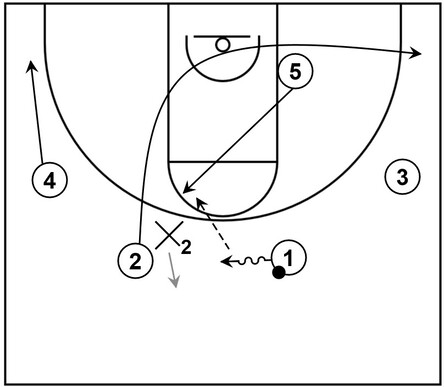
At the start, 1 would like to perform the slot to slot pass. However, X2 takes away that action, particularly by placing a hand in the passing lane, represented by the gray arrow.
Therefore, 1 simply dribbles toward the top and uses the non-dribbling off hand to wave 2 through to the right side corner.
What’s more, as that happens, 5 moves toward the left side elbow area via a flash cut and receives the ball from 1.
Additionally, 4 spaces out to the left side empty corner for the time being.
Part 2: Pin down and slip
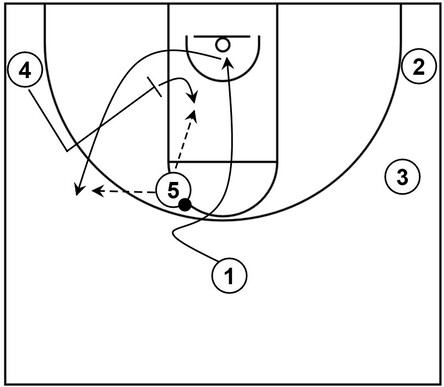
Next, 1 cuts under 5, initially looking for a handoff. However, that is not available so 1 continues to cut toward the basket.
Moreover, as 1 is moving towards the basket, 4 begins to fake cut toward the adjacent left side wing before cutting down near the left side low post area to set a pin down screen with 1 as the recipient.
After that, 1 uses that screen, cuts to the left side wing area, and could receive the ball from 5, which could lead to a possible open jump shot.
Alternatively though, 4 could slip the pin down screen action, step into the lane, receive the ball from 5, and score around the basket.
Point Over
This is a basic example of primary actions within the Point over set, initiated from the 2-2-1 alignment.
Part 1: Slot to slot pass, cut through, and high post entry pass
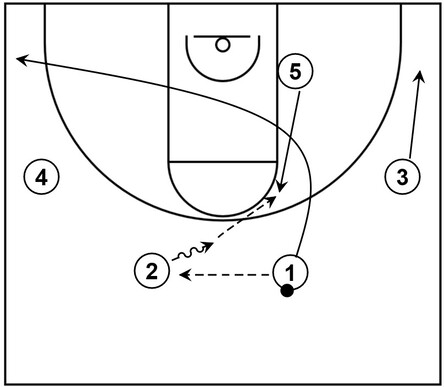
To start, 2 receives the ball from 1 via the slot to slot pass. After that, 1 cuts through to the left side corner. As that happens, 5 lifts up to the right side elbow while 2 dribbles toward the top from the left slot.
Following that, 5 receives the ball from 2 while 3 fills the right side corner.
Part 2: Wide pin down screen and curl cut
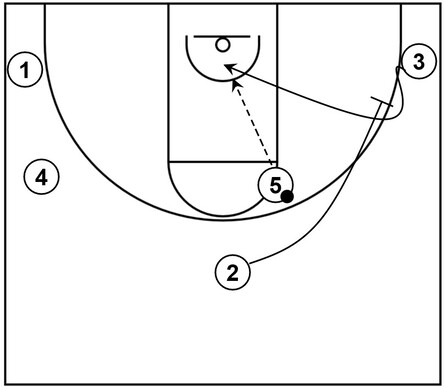
Next, 2 cuts over the top of 5 to set a wide pin down screen with 3 as the recipient. From there, 3 uses that screen, executes a curl cut towards the basket, and can receive the ball from 5 to score points near the rim.
Additional resources to potentially learn more about the Princeton offense
This section contains additional resources that could be potentially useful to learn more about the Princeton offense.
Effective Sets out of the Princeton Offense: “Point” – YouTube
How To Run The Princeton Offense Chin Series – YouTube
Breakdown Drills for Chin – YouTube
Princeton 2-Guard Offense 3-on-0 Breakdown with Josh Loeffler! – YouTube
Winning with the Princeton Style Offense by Lee DeForest – Championship Productions
NBA Coaches Playbook (Chapter 7, Princeton Offense by Eddie Jordan and Pete Carril) – Amazon